Solution concept
Technical
The truck shuttle trains each form a fixed train set consisting of a standard locomotive suitable for the required performance profile, a passenger car to accommodate the drivers during the journey and 25 new special cars, one of which is designed as a control car at the end of the train.
The technical design of the special wagons, as well as the design of the loading stations, make it possible to use the train's idle time of no more than 15 minutes to perform boarding and disembarking operations on all wagons at the same time.
Rolling stock
The special wagons required represent a new development. The contact height of the carriageway is to be approx. 330 mm above the top of the rail, which means that regular trucks can be transported on most main haulage routes.
The loading length of the special wagons is adapted to the truck length of approx. 19 m used today. By using standard wheelsets and bogies, high driving speeds can be combined with low maintenance costs.
The deep loading principle required for this requires a cranked frame structure to absorb the tensile and impact forces that occur.
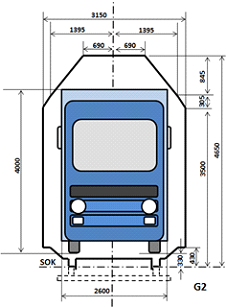
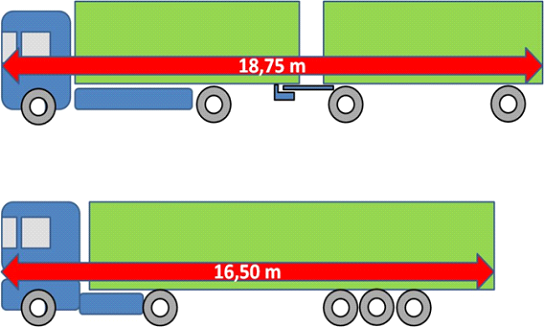
The bridge section in between has the free space to accommodate the necessary lifting and turning functions, which guarantees fast loading and unloading. This is made possible, for example, by the insertion of a floor panel which can be raised as a whole within the functional cutout to the upper edge of the frame structure and is connected to a pivoting center console. The truck itself is positioned in a lifting or loading tray provided with a track contour for centering.
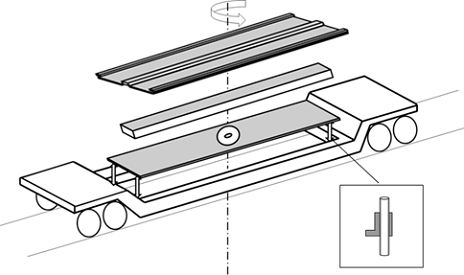

In order to safeguard the pure standing time for getting on and off and at the same time also to minimize the stopping time, the entire lifting/loading tray, whether empty or loaded with a truck, could also be conveyed from the special wagon in the turned-out position. In the same work step, a lifting/loading tray waiting on the opposite side, whether empty or loaded with a truck, would then be conveyed onto the transport wagon. The necessary preparation times for shunting, positioning and locking would thus not be carried out during the loading process, but already before the arrival of the train.
The entire train assembly should be designed as a covered unit, where the cover is lifted and rotated with the bridge section.


This serves to protect against negative weather influences and will significantly increase functional reliability. The aerodynamics of the train set are also favored at higher speeds. Less turbulence is created and air resistance is reduced, which in turn has a positive effect on energy consumption. In addition, the roof represents a measure against the risk of components such as tarpaulins coming loose on the truck.
Since the use of electric trucks is expected to increase in the near future, as the development activities of leading manufacturers show, every special wagon should have a charging station so that the travel time can also be used for recharging. In this way, the current range limit of approx. 400 km per charge could already be significantly extended and the earlier use of this type of drive in freight transport could be achieved. As the truck shuttle can use the entire European rail network, any point within Europe could already be reached by e-truck today, all that is needed is an appropriate loading station on site.
Loading stations
Each loading station requires only 1 working track for all boarding and alighting processes. For exceptional cases, an incident track should be installed at the edge of the station area. The following station variants can occur in planned network operation:
⦁ Terminal station
After the loading process, the arriving train leaves the station in the direction from which it came.
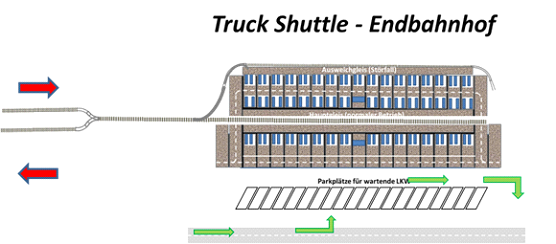
⦁ Through station
Arriving trains continue in the original direction of travel after the loading process.
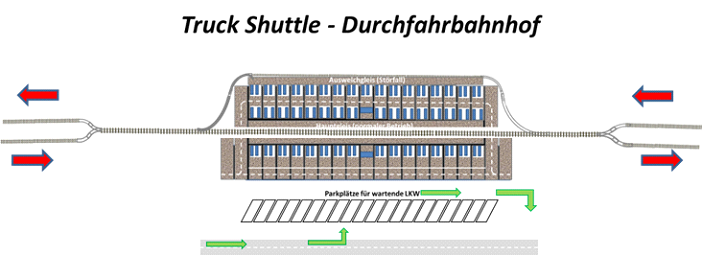
⦁ Crossing stations
Arriving trains also keep their direction of travel, but after leaving the station they branch off into the direction of travel assigned to them in network operation (north/east/south/west)
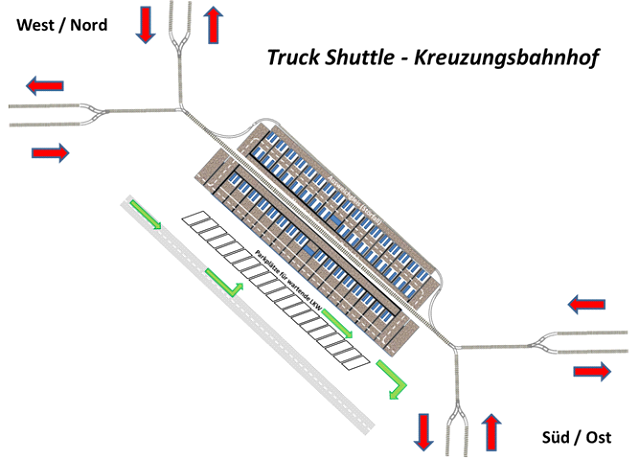
In order to keep the standing time of a truck shuttle train below 15 minutes, the loading stations must meet special requirements. For example, there must be a level and sufficiently wide passable surface on both sides of the working track along the entire length of the train. The level of this surface must be such that the lifting/loading trays can turn out exactly over this surface.
The stopping positions of the individual carrying wagons must be marked on both sides of the loading track and numbered in a clearly visible manner (so-called access numbers) so that the trucks can enter the corresponding lifting/loading tray before the train arrives.
Feeder
In order to make the use of the 'Truck Shuttle' system attractive, the loading stations should be easily accessible and therefore located close to freeway interchanges, freeway service areas or car stations. The feeder roads should be designed to be suitable for trucks and, if possible, have a dedicated truck lane to facilitate reaching the station on time on the one hand and to limit obstruction of other traffic on the other.
Waiting areas
Since not every truck arrives at the loading station immediately before its 'boarding date', parking areas must be provided for a total of 3 different waiting areas. First, the loading station must have a sufficiently large truck parking area as waiting area 1. This can be used for longer waiting periods by trucks that do not have a ticket yet or whose 'boarding time' is booked much later.
In addition, a waiting area 2 must be created where trucks park that already have a ticket for the next or next but one 'truck shuttle' train but do not yet have an exact transport wagon assignment ('boarding number'). This area should have illuminated signs that inform the driver in a timely manner to which 'boarding number' next to the track he must proceed.
Finally, the marked area next to the track serves as waiting area 3 (entry side), from which the driver drives directly into the 'lift/load tray' placed there. On the approach to its 'entry point', each truck must pass through a separate lane that reflects both the shape of the lift/load tray and the overall clearance gauge. This ensures that no complications arise later when the lifting/loading tray is transported onto the special wagon and during the journey.
Entry/Exit
Immediately after the train stops, the middle section of the special wagon is lifted together with the envelope structure and the lifting/loading shells of each transport wagon to be loaded and/or unloaded and rotated by 90° (driver's cab to the front). Now, the receptacles of the loading trays are moved on the platform under sensor control so that they are precisely aligned with the respective wagon. The lifting/loading trays are now transported empty or loaded with a truck from the wagon and, in the same operation, another lifting/loading tray is transported empty or loaded with a truck from the opposite side onto the wagon. The driver of the unloaded truck gets in, the truck drives out of the lifting/loading tray and leaves waiting area 3 (exit side). The driver of the 'boarding' lorry has already got out here and entered the accompanying wagon.
Logistic
In order to be able to offer a transport service that covers as much of the country as possible, 'truck shuttle' lines should run in an east/west direction on the one hand and in a north/south direction on the other, thus forming a grid-like network with a mesh size yet to be defined. The decisive factor here is the already existing delivery routes. For the alignment of the transport network, the existing flows of goods are to be analyzed and, in particular, the already existing transfer stations of the large forwarding companies are to be included in the planning.
Truck Shuttle Plan Network
Basically, all planning activities carried out so far are based on the already existing and usable route network of DB AG. For illustration purposes and as a basis for initial cost considerations, the following line grid was assumed as an example
Individual routes:
N/S route 1 (Bremen-Basel) approx. 750 km
N/S route 2 (Flensburg-Singen) approx. 900 km
N/S route 3 (Schwerin-Garmisch) approx. 800 km
N/S route 4 (Rostock-Dresden) approx. 400 km
O/W Trasse 1 (Stettin-Emden) approx. 550 km
O/W Trasse 2 (Frankfurt Oder-Duisburg) approx. 600 km
O/W Trasse 3 (Bautzen-Saarbrücken) approx. 650 km
O/W Trasse 4 (Passau-Karlsruhe) approx. 450 km
When choosing the location of individual loading stations, the following criteria must be taken into account for strategic reasons:
⦁ Always at the route end and at grid accounts
⦁ As far as possible on the edge of conurbations
⦁ Always near freeways and with feeder roads
⦁ 150 to 250 km distance between loading stations
⦁ Preferably near industrial/commercial areas
Cycle operation
Having the truck shuttle train run every hour in each direction is an optimal offer for potential users to plan into. A driver who is on an interregional trip can thus find out at any time whether there is a transport offer for him in the desired direction. In analogy to the normal passenger in passenger traffic, he can therefore select the train that is suitable for him.
Booking system
Ticket booking should be done exclusively online. Every potential customer must be able to easily see whether there is free capacity in the direction he wants at the time he wants. The complete price must also be displayed immediately so that a quick decision (driver/carrier) can be made on the booking. Since, as described at the beginning, there are many disruptive factors that can influence the planning of the forwarder at short notice, the booking system must also be able to react to such short-term changes. It is also important here that the driver has an app on his smart phone, for example, which allows him to react to disruptions at very short notice. He knows best whether he can still manage one transport offer or has to rebook for another.
The sooner he announces his forced cancellation, for example, the sooner the freed-up capacity can be booked elsewhere. If, contrary to expectations, the truck is not at its 'boarding number' until approx. 15 minutes before the planned and booked departure time, the space will be allocated to another interested party according to the waiting list procedure.
Summary
Truck Shuttle: Is a special wagon for holding complete trucks. The middle section can be lowered to the lowest possible position (driving position). At the station, it is raised to the required loading and unloading height
Truck shuttle train: Is a fixed train set consisting of a locomotive, a passenger coach and 25 special wagons.
Truck shuttle concept: This is the scheduled/scheduled use of truck shuttle trains in a grid network based on the existing EU route network. Loading stations are located at the end points and all junctions of the routes.

